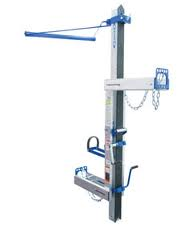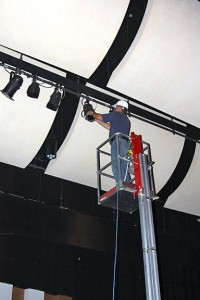There are two types of braces for aluminum pump jack scaffolding: The rigid brace and the folding brace. In the rigid brace, the piece resting against the roof does not swivel, allowing it to provide unmoving support. In the folding brace, there are two separate supports, each of which can swivel. This allows it to provide support against two planes with differing angles. There are advantages to both, and generally we recommend that you own both styles. Each scaffold will usually need both types, as described below. Continue reading
Category Archives: OSHA fall prevention
Aluminum Pump Jacks Offer Benefits of Efficiency
 Using aluminum pump jack scaffolding is one of the most efficient ways to do any type of work on a house. Jobs where scaffolding is essential include painting, carpentry, masonry and exterior cleaning.
Using aluminum pump jack scaffolding is one of the most efficient ways to do any type of work on a house. Jobs where scaffolding is essential include painting, carpentry, masonry and exterior cleaning.
Be sure to adhere to all OSHA rules for erecting pump jack scaffolding, using equipment with two positive gripping mechanisms for a secure grip. Do not try to improvise scaffold platforms. Workbenches and other items not intended for the purpose should not be used.
Continue reading
Reechcraft PowerLift ML60
ReechCraft, Inc. is excited to introduce the newest product to their line of innovative access solutions. The 25 foot PowerLift® will give operators the ability to take their jobs to new heights.
The 20 foot working height on the Reechcraft PowerLift ML60 is known for being lightweight as well as easy to operate, transport and store, and the 25 foot lift is no different. Due to its compact size and maneuverability, the product is designed to go where other lift products can’t, like down stairs or in tight spaces. The added height makes it a perfect solution for those jobs that are just out of the 20 foot platform’s reach.
PowerLift is a great option for facility managers, maintenance professionals, contractors, builders and homeowners and has a wide variety of applications. The unique lift is built for one operator, and the only tool needed to operate the lift is a simple cordless or corded drill.
How much does a jobsite injury really cost?
I recently can across a very interesting tool to help you to realize how much does a jobsite injury cost you. Employers can use the” $afety Pays” to assess the impact of occupational injuries and illnesses on their profitability. This program uses a company’s profit margin, the average costs of an injury or illness, and an indirect cost multiplier to project the amount of sales a company would need to generate to cover those costs. The program is intended as a tool to raise awareness of how occupational injuries and illnesses can impact a company’s profitability, not to provide a detailed analysis of a particular company’s occupational injury and illness costs. Your local OSHA On-site Consultation Office can help small businesses identify workplace hazards and develop and implement an effective injury and illness prevention program. This tool is part of the OSHA Small Business program that provides links to numerous OSHA resources and information designed specifically for small business employers, including safety and health tools and publications, easy-to-follow guides for specific OSHA standards, and descriptions of benefits that small businesses receive from OSHA. The page also includes information on the Safety and Health Achievement Recognition Program (SHARP), which recognizes small business employers who operate exemplary injury and illness prevention programs.
Surviving an OSHA inspection.
Here is a link to an article that is very informative on how to deal with and survive an OSHA inspection. It covers the four steps of an inspection. The opening conference, the inspection, the closing conference and the citations. It also states the importance of having a designated employee at the job site. They state that the odds of an OHSA inspection is less that 1% is is important to have a plan.
OSHA Guide to Scaffold Use in Construction
OSHA’s Safety Standards for Scaffolds publication. This informational booklet is intended to provide a generic, non-exhaustive guide to scaffold use in construction. This publication does not itself alter or determine compliance responsibilities, which are set forth in OSHA standards themselves and the Occupational Safety and Health Act of 1970.
OSHA also has a list of publications covering many other issues that effect business operations. Most of these can be downloaded and used as handouts. They are also offered in different languages.
They also offer links to online training for the OSHA 10 hr, 30 hr. construction courses and also the 10 hr. and 30 hr. general industry course.
Moreover, because interpretations and enforcement policy may change over time, for additional guidance on OSHA compliance requirements, the reader should consult current administrative interpretations and decisions by the Occupational Safety and Health Review Commission and the courts.
Material contained in this publication is in the public domain and may be reproduced, fully or partially, without permission of the Federal Government. Source credit is requested but not required.
Fall Prevention
Here is a link to a web site for information on fall prevention. It is a good site for employees to visit for information on fall prevention ideas.
Battery Powered Scaffold
Granite Industries has developed a new product that is designed to help eliminate OSHA citations when using narrow rolling scaffold. When working on narrow scaffold the wheels must be locked. When employees are doing repetitive work, which require constant moving of the scaffold from one location to another, employees tend to forget to lock the casters. In some cases they move the scaffold while on it. Trades that do this can be painters, electricians, and ceiling installers. Granite has developed a motorized narrow scaffold that will eliminate the issue of not locking the casters and also increase production by eliminating the need to get down off the scaffold to move it. The product is called Power Snappy. It is available in three sizes. It is battery powered by two 12 volt sealed batteries, has a built in battery charger, all controlled by a joy stick while standing on the work platform. It can transported easily, both to and around the job site and will fit on a standard elevator.
Fall Protection Video
This fall protection video outlines the steps to develop safe practices when working from heights including a fall protection plan and proper protection equipment.
On April 10, at 11 a.m. EST, OSHA’s Director of Construction Jim Maddux, and NIOSH’s Director of Construction Safety and Health, Dr. Christine Branche, will co-moderate a webinar to discuss ways of stopping the leading killer of construction workers – falls from heights. To register for the free webinar and to learn more about efforts by OSHA, NIOSH and CPWR to protect construction workers from fatal falls, visit the registration
Werner Fall Protection Full Body Harness
Werner has three basic types of fastening systems on there Full Body Harnesses. Parachute, Quick connect, and Tongue Buckle. Everything they manufacture has 5 point adjustment. We would not recommend 3 point adjustment on a harness due to circulation issues if a fall does occur.
The parachute or pass-through style is the least expensive and comes on the harnesses that are generally less than $50.
You will find it in the roofers kits, and any price point product. Again, beware of three point adjustment.
This is the worst type of fastening system. It constantly is loosening up, and creates a situation where the worker is not “fitted” properly and can be fined by OSHA.
The Quick connect is the most expensive version available, this was created to make it quick to disconnect with your gloves on.
There are certain scenarios that this may be necessary.
Generally though, this buckle is harder to adjust for comfort and is similar to the parachute buckle in the loosening up part.
The Tongue Buckle, is the middle of the road in price. But it is far and away the best type of fastening system. There are two reasons: first is that it is a fixed in place, it will not loosen up on you. The second is that it is very easy to adjust.
Here are some harnesses made by Werner Ladder.








